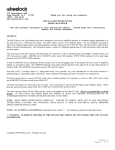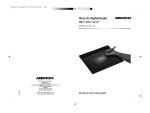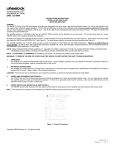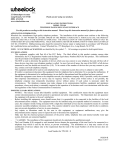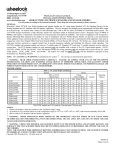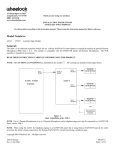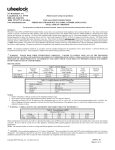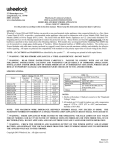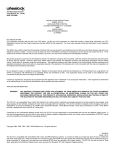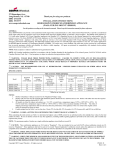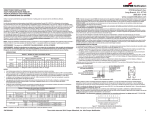Download Wheelock PAMX-125 Specifications
Transcript
273 Branchport Avenue Long Branch, N.J. 07740 (732) 222-6880 INSTALLATION INSTRUCTIONS MODEL PAMX-125 PAGING AMPLIFIER GENERAL: The PAMX-125 combines an eight channel mixer with a 125 Watt RMS amplifier in a single unit. The PAMX-125 amplifier offers a choice of ten different inputs: five low impedance microphone inputs, one telephone paging input, three high impedance auxiliary inputs and one PATCH IN input. The PAMX-125 allows eight of these inputs to be used simultaneously: four microphone inputs, a choice of a telephone paging input or a fifth microphone input, and three auxiliary inputs. The front panel of the amplifier features individual input level controls; as well as, MASTER gain and TREBLE / BASS controls, LO CUT horn protect switch, LIMITER (ALC) ON/OFF switch, power ON indicator, INPUT PEAK indicator for the eight input channels and an OUTPUT PEAK indicator. A built-in LIMITER circuit compensates for the varying voice levels and paging styles of the people who have access to telephone paging or a microphone input. The LIMITER maintains rated output without distortion when input level exceeds rated input by as much a 20dB. The LIMITER circuit affects only the MIC and TEL inputs. Note that (AUX 1) auxiliary input (i.e., background music, tone generator, etc.) will automatically be soft muted whenever a telephone page or a microphone page is generated. After completion of the page, the music will return to its original level. On the rear panel there is a power ON/OFF switch with a switched auxiliary AC receptacle, as well as a MIC 5/TEL select switch and a PRE/POST EQ select switch for the LINE OUT (See Figure 7). All inputs and outputs are connected at rear panel. Screw terminals are used for the Microphone and Telephone Inputs. Phono jacks are used for Auxiliary Inputs, LINE OUT, TAPE OUT, PATCH OUT and PATCH IN. The audio power output is connected via screw terminals (See Figure 8). The amplifier operates from 115VAC, 60Hz and has a power consumption of 175 Watts. There is no external fuse or circuit breaker. IN THE EVENT THE AMPLIFIER DOES NOT POWER UP, HAVE THE TROUBLE INVESTIGATED BY AN AUTHORIZED SERVICE TECHNICIAN OR RETURN UNIT TO FACTORY. NOTE: READ THESE INSTRUCTIONS CAREFULLY. FAILURE TO COMPLY WITH ANY OF THE FOLLOWING INSTRUCTIONS, CAUTIONS AND WARNINGS COULD RESULT IN RISK OF ELECTRICAL SHOCK, IMPROPER APPLICATION OR INSTALLATION. NOTE: All CAUTIONS and WARNINGS are identified by the symbol . All warnings are printed in bold capital letters. WARNING: TO REDUCE THE RISK OF FIRE OR ELECTRIC SHOCK, DO NOT EXPOSE THIS UNIT TO RAIN OR MOISTURE. 1. UNPACKING: The amplifier was carefully checked before leaving the factory. Inspect shipping container and unit carefully for indication of improper handling. If the unit has been damaged, make an immediate claim to the carrier. 2. MOUNTING INSTRUCTIONS: The mixer is provided with five mounting feet for placement on a shelf. An optional Rack Mount Kit (PA-RMK) is available for mounting in standard EIA 19” racks. Refer to PA-RMK installation instructions (P83258) for mounting. CAUTION: These devices are not intended for use in hazardous locations as defined by the National Electrical Code (NEC). 3. POWER AND GROUNDING (SEE FIGURE 1): The 115VAC line cord has a three-prong plug which should be plugged into a three wire grounded electric outlet. It is very important to maintain the amplifier ground for safe and trouble-free operation. If there is no grounded electric outlet, connect a wire from the GND terminal on the OUTPUT terminal strip to a water or steam pipe. P83242 C Sheet 1 of 9 Copyright 1996 Wheelock, Inc. All rights reserved. 4. POWER SWITCH AND RECEPTACLE (SEE FIGURE 1): The ON/OFF power switch located on the rear panel controls both the internal power of the amplifier and the accessory IEC female outlet. Note: The accessory to be attached and controlled by the ON/OFF switch must not exceed 3 Amps at 115VAC. Figure 1: Power Connections 5. SPECIFICATIONS: Table: Description 1. Power Output at 1KHz 2. Total Harmonic Distortion 3. Outputs Inputs 4. Impedance 5. Sensitivity 6. Frequency Response 7. Signal to Noise Ratio 8. Type of Input 9. Controls 10. Indicators 11a. Treble Control 11b. Bass Control 12. Lo-Cut Switch Automatic 13. Limiter for Paging Automatic 14. Mute Operation Outputs from 15. Mixer 16. 17. Input to Power Amplifier Regulation 18. RFI Protection 19. Environmental 20. Input Power 21. 22. 23. 24. 25. 26. Consumption Weight Dimensions FCC UL CSA (Pending) 1 PAMX-125 Tolerance 125 Watts RMS ±1dB 1% at Full Rated Output at 1KHz 125 Watts at 8 Ohms, 25V, 70.7V, 100V (1) Telephone (4) MIC (3) AUX 600 Ohms 600 Ohms 47K Ohms (-18dBM) 100mV 4mV 175mV 150Hz-15KHz 50Hz-20KHz 50Hz-20KHz ±1% ±1dB -----N/A TEL ± 2dB MIC ± 1.0mV AUX ± 20% ± 2dB 65dB Transformer Isolated/Bal. 65dB 70dB - 3dB Balanced or Unbalanced Unbalanced -----Level Control: (1) TEL/MICS (4) MIC (3) AUX BASS, TREBLE, MASTER GAIN LIMITER Select Switch, LO-CUT Switch TEL/MIC 5 Select, PRE/POST EQ for LINE OUT Green LED - Power On Input Peak Indicator, Output Peak Indicator -12dB to +12dB at 10KHz ± 3dB +12dB to -12dB at 100Hz ± 3dB -6dB at 250Hz ± 2dB ± 2dB Output Level Maintained Without Clipping, Even While Exceeding ± 1dB Rated Input Level Up to 20dB. 40dB Muting of AUX 1 Output Level with Nominal Page Input LINE OUT: ≥ 1V at RL = 150 Ohms PATCH OUT: ≥ 1V at RL = 150 Ohms TAPE OUT: -10dB from PATCH OUT ≥ 1V, into 10k Ohms Isolated ≥ 1500V No Load to Full Output Less than 2dB RFI Test: Use CB Transmitter Output in Same Room - Minimum 20 Ft. from Amplifier - No Pickup. 0 Degrees C-49 Degrees C 85% R.H. Noncondensing 90V-132VAC 50/60Hz 175 Watts Max 18.5 lbs. 3.5"(H) 17"(W) 14"(D) Part 15 813 CAN/CSA C22.2 No. 1-M-90 -----± 20% Comments 90-132VAC 50Hz/60Hz Rated Output 8 Ohms Do Not Operate at NO LOAD -----at 1KHz To Produce Rated Output Ref. 1KHz at 1W -3dB Roll-Off No "Hum" -----Front Panel Front Panel Rear Panel Front Panel Ref. 1KHz at 1W Ref. 1KHz at 1W ----------Mute of Music Output While Page is Activated LINE OUT Selectable PRE/POST-EQ PATCH OUT = PRE-EQ Input from Mixer to Amplifier ------ Gain Control On Input Amp Stability ------ ------ -----Power Factor Corrected ------------------------------- --------------------Rack Mount 19"(W) ---------------- P83242 C Sheet 2 of 9 6. TELEPHONE PAGING INPUT (SEE FIGURE 2): Connect telephone paging interface wires to the input screw terminals marked TIP (+) and RING (-). Set MIC 5/TEL switch (rear panel) to TEL position. For Tip and Ring connections to various types of telephone paging access, see Figures 6A, B & C. For Tip and Ring connections to Wheelock Zone Controls, refer to the specific zone control installation instructions. 7. MICROPHONE INPUTS (SEE FIGURE 2): (A)Connect balanced low-impedance microphone wires to the input screw terminals marked (+) and (-). The shield must be connected the GND screw terminal. to (B) An unbalanced microphone may be connected to the same screw terminals; the signal to (+) and the shield to (-). The (-) input terminal must be connected to the adjacent screw terminal marked GND. Install a jumper wire between the unused screw terminal the GND screw terminal. and Note: To avoid possible interference, the microphone input cable should be a shielded cable, with the shield connected to the input GND terminal. Figure 2: Input Connections 8. AUXILIARY INPUTS (SEE FIGURE 2): To connect an FM tuner, CD player, tape player, tone generator, or any other line level program source to AUX 1, 2 or 3 input jack on the rear panel, use a single conductor shielded cable terminated in a standard RCA type phono plug. Note that AUX 1 is automatically soft muted by any active MIC or TEL input. Neither AUX 2 nor AUX 3 is muted by paging inputs. The LIMITER circuit does not affect any of the AUX inputs. 9. LINE OUT (SEE FIGURE 2): The LINE OUT is the mixed audio signal which can be selected either before the TREBLE/BASS controls (PRE-EQ), or after TREBLE/BASS controls (POST-EQ). The LINE OUT (PRE-EQ/POST-EQ) select is on the rear of the unit adjacent to the LINE OUT phono jack. The LINE OUT signal is pre-master and is unaffected by changes in the MASTER gain control. 10. PATCH OUT - PATCH IN AND TAPE OUT (SEE FIGURE 2): The PATCH OUT signal is the mixed audio signal before the TREBLE/BASS and MASTER gain controls to the amplifier. The TAPE OUT signal is the same as the PATCH OUT but reduced 10dB for line matching to various recording formats. The PATCH OUT signal is available for external audio processing, for example, an outboard graphic equalizer. If external audio processing is used, the resultant signal is to be returned to the amplifier at PATCH IN. The insertion of a phono plug at PATCH IN will replace the internal mixed audio signal with an external audio signal. The insertion of an RCA phono plug into the PATCH OUT will also disconnect the mixed audio signal from the tone and gain controls, requiring the external processed audio to be applied at PATCH IN. When using external audio processing, the TREBLE/BASS controls should be set to the center or balanced position. Note: The insertion of a phono plug in either the PATCH OUT or PATCH IN phono jack will disconnect the internal mixed audio from the TREBLE/BASS and the MASTER gain controls. P83242 C Sheet 3 of 9 OUTPUT CONNECTIONS (SEE FIGURE 3): 11. AUDIO OUT: Connect (2) output wires from the speaker load, to the COM screw terminal and the selected constant voltage terminal, (i.e. 25V, 70.7V or 100V). The constant voltage distribution method facilitates the use of multiple speakers in parallel with a single amplifier. Note that each speaker must have its own 25V, 70.7V or 100V line-matching transformer. Select the wattage tap on the line matching transformer of each speaker, for the power (gain) desired. An 8 Ohm speaker load may be connected to the COM and the 8 Ohm terminals. The audio output is available at the rated output of 125 Watt for an 8 Ohm load, for a 25V, 70.7V or 100V. The GND and COM terminals of the AUDIO OUT terminal block are chassis ground. The shield of audio output shielded cable should be terminated to this GND (if applicable). Note: The wattage rating of the speaker loads should not exceed total power rating of the amplifier. The following Table 2 below will provide the appropriate line loss that should be calculated on to those expected speaker loads. CAUTION: Do not operate amplifier without a proper load attached to audio out terminals. CAUTION: Do not connect / dissconnect wiring or cabling with power applied. 12. AWG Size 10 12 14 16 18 20 22 PROPER WIRE SIZE/LENGTH: To minimize power loss in the system cabling, use a wire gauge suitable for the power being distributed and the length of cable. Use the following table as a guide. Max Power AWG Per NEC Per NEC 1,060W 420W 210W 70W 35W Table 2: 2 Wire Copper Cable Lengths for Speaker Lines at 0.5dB Loss in SPL (12.5% Power Loss in Watts) Low Impedance 70 Volt Speaker Line Speaker Line Nominal Power in the Load Length in Feet 8 Ohms 10W 15W 20W 40W 60W 100W 125W 200W 240 15,000 9,900 7,500 3,750 2,500 1,500 1,180 730 150 9,100 6,200 4,680 2,340 1,560 940 730 460 95 5,600 3,800 2,880 1,440 960 600 450 280 60 3,600 2,400 1,870 930 620 370 290 180 40 2,300 1,500 1,150 570 380 230 180 110 25 1,400 960 730 360 240 ---------15 900 600 460 ---------------- AWG Size 250W 590 370 220 140 ---------- 400W 370 230 140 90 ---------- 500W 290 180 110 ------------- 10 12 14 16 18 20 22 Notes: 1) For 25V line divide all 70.7V lengths by 8. 2) For 100V line multiply all 70.7V lengths by 2.0. 3) To allow for future expansion and distribution cable line loss, it is recommended that the total system wattage should not exceed 85% of the amplifier’s rated output. (i.e. 106 watts for the PAMX-125). 4) The total system wattage requirement is the summation of the wattage tap selections of all system speakers and horns. 5) In no case should the wattage rating of the speaker loads exceed the total power rating of the amplifier. Figure 3: Output Connections WARNING: THE COVER FOR THE 100V AUDIO OUTPUT TERMINAL MUST BE ATTACHED AT ALL TIMES. THE POWER CORD MUST BE DISCONNECTED BEFORE CONNECTING TO THE 100V TERMINAL. THE COVER MAY BE REMOVED TO CONNECT A WIRE TO THE TERMINAL, BUT IT MUST BE REATTACHED AFTER CONNECTING THE WIRE(S). FAILURE TO MAINTAIN THE TERMINAL COVER IN PLACE COULD EXPOSE YOU AND/OR OTHERS TO ELECTRICAL SHOCK WHICH COULD RESULT IN SERIOUS INJURY AND/OR DEATH. P83242 C Sheet 4 of 9 13. CASCADING AMPLIFIERS (SEE FIGURE 4): The LINE OUT of the PAMX-125 amplifier, which is the resultant mixed audio signal of the eight input channels, can be used as an AUX or PATCH IN input to another PAMX-125, a program source for professional level recording formats, or as a LINE IN input to a PA-250 or PA-500 to expand existing systems or, to distribute large speaker loads. Note: Use shielded cable for all interconnections. Note: The LINE OUT signal can be selected to be output prior to, or after, the TREBLE/BASS controls, (PRE/POST EQ). Figure 4: Cascading Amplifiers 14. TO CONNECT A TAPE RECORDER (SEE FIGURE 5): A tape recorder can be connected to record live programs (microphone inputs), or all of the amplifiers activities (all inputs). A separate phono jack is available for TAPE OUT. The TAPE OUT signal is the same as the PATCH OUT signal but reduced in level by 10dB. Both the PATCH OUT and the TAPE OUT signals are the mixed audio signal prior to the TREBLE/BASS and MASTER gain controls. Figure 5: Connecting a Tape Recorder CAUTION: Do not block air flow. Do not stack. Do not operate vertically. When rack mounting, it is necessary to have a minimum of 1.75 above and 1.75 below unit to allow for adequate air flow. Failure to do so could result in excessive heat which could damage the amplifier. P83242 C Sheet 5 of 9 15. TELEPHONE PAGING ACCESS CONNECTIONS: Figure 6A: Audio Page Port Figure 6B: Analog Station Extension Port Note: Maximum primary DC current not to exceed 10mA for telephone input. Refer to Wheelock’s TPI-100 installation instructions (P82030) for internal control settings and adjustments. Figure 6C: Unused Co Line/Trunk Port or Stand Alone Telephone Note: Maximum primary DC current not to exceed 10mA for telephone input. CAUTION: Connect only to PBX or KSU incorporating isolation from public telephone network. P83242 C Sheet 6 of 9 OPERATION: WARNING: DO NOT OPEN COVER! NO USER SERVICEABLE INTERNAL COMPONENTS! REFER TO QUALIFIED SERVICE TECHNICIAN. IF UNIT IS OPENED, WARRANTY IS VOIDED. Figure 7: PAMX-125 Front Panel 16. POWER INDICATOR: Green LED indicator illuminates when AC power is applied to the amplifier. 17. MASTER GAIN CONTROL: Adjusts the total output level of the amplifier without disturbing the individual settings of the microphone, telephone and auxiliary input LEVEL controls (set at factory in minimum position). 18. OUTPUT PEAK INDICATOR: The indicators, as the amplifier output is increased, illuminates within 2dB of full rated output. 19. MIC 1 THROUGH MIC 4, TEL/MIC 5, AND AUX 1 THROUGH AUX 3 LEVEL CONTROLS: Adjusts the input level of each audio channel. If the level of any individual audio channel or the level of any combination of audio channels mixed, would exceed the rated output of the Mixer with Mixer set at Max, the INPUT PEAK indicator will illuminate. When the INPUT PEAK indicator illuminates, the Mixer is approaching clipping of the audio signal. 20. INPUT PEAK INDICATOR: The INPUT PEAK indicator will illuminate as the input of any of the eight audio channels approach clipping. If any of the paging inputs approaches clipping, activate the LIMITER to allow paging inputs up to 20dB overdrive. 21. TREBLE AND BASS CONTROLS: Adjusts TREBLE and BASS for optimum tonal balance of the output signal. The amplifier frequency response is flat with the knob indicators pointing straight up (centered). 22. LIMITER OFF/ON SWITCH: LIMITER switch in the ON position prevents clipping of the paging audio inputs when the paging inputs exceed the rated input by as much as 20dB. The LIMITER circuit does not affect any of the AUX inputs. 23. LO CUT (HORN PROTECT) SWITCH: Turn the switch ON whenever horns are used in the system. When LO-CUT is active, the low frequency cut-off is 6dB down at 250Hz. This will protect the horn voice coils from damage by filtering out excessive bass energy which can cause damage to horn drivers at high power settings. P83242 C Sheet 7 of 9 Figure 8: PAMX-125 Rear Panel 24. POWER ON/OFF SWITCH AND RECEPTACLE: The amplifier is designed to operate from a line voltage of 115VAC at 50/60Hz. The IEC 320 receptacle has a male input to connect a grounded line cord and female output for attaching a switched external auxiliary load. The external auxiliary load is not to exceed 3 Amps at 115VAC. 25. MIC 1, MIC 2, MIC 3, AND MIC 4 AND MIC 5, TEL TERMINAL BLOCKS: Three terminals are used for each MIC or TEL input. The center terminal for each input allows for the attachment of the shield for that input cable. To maintain proper signal polarity, the plus signal should be attached to the (+) terminal and the minus signal should be attached to the (-) terminal. Note: To prevent the input overdrive from clipping, the LIMITER must be active. 26. MIC 5/TEL SELECT SWITCH: This switch allows the selection between the MIC 5 and TEL (Balanced transformer-isolated) inputs for the fifth paging audio input. Switch position to the left for MIC 5, and to the right for TEL input. 27. AUX 1, AUX 2, AND AUX 3 PHONO JACK INPUTS: AUX 1 is a high impedance input, automatically MUTED by any paging input, for an FM tuner, CD player, tape player, tone generator, or any other line level program source (i.e., MIC/LINE mixer). The AUX 2 and AUX 3 are the same as the AUX 1 without the MUTE. The AUX inputs are not affected by the LIMITER circuit. 28. LINE OUT (PHONO JACK) WITH PRE/POST EQ SELECT: The LINE OUT is the mixed audio signal that can be used to drive booster amplifiers when additional audio power is required. The LINE OUT can also be used to drive self-amplified speakers at line level. The LINE OUT can be selected as an output either before the TREBLE/BASS control (PRE-EQ), or after the TREBLE/BASS control (POST-EQ). The switch position to the left selects PRE-EQ, and to the right selects POST-EQ. 29. PATCH OUT, TAPE OUT AND PATCH IN PHONO JACKS: The PATCH OUT is the mixed audio signal at line level prior to the TREBLE/BASS control. This signal is available to drive an external audio processor. The resultant processed audio signal is to be reapplied to the PAMX-125 at the PATCH IN. The TAPE OUT is the same signal as the PATCH OUT but is reduced 10dB. When an external audio processor is used, both the TREBLE and BASS control should be centered. Note: When a phono plug is placed in either the PATCH OUT or PATCH IN phono jack, the mixed audio signal is disconnected before the TREBLE/BASS and MASTER gain control. The outboard processed signal is to be reinserted at the PATCH IN jack. 30. SPEAKER OUTPUTS: The audio output is available at the rated output of 125 Watts for an 8 Ohm load, for a 25V, 70.7V or 100V. The GND and COM terminals of the AUDIO OUT terminal block are chassis ground. The shield of the audio shielded cable is to be terminated to this GND. Connect (2) output wires from the speaker load, to the COM screw terminal and the selected constant voltage terminal, (i.e. 25V, 70.7V or 100V). The constant voltage distribution method facilitates the use of multiple speakers in parallel with a single amplifier. Note: Each speaker must have its own 25V, 70.7V or 100V line-matching transformer. Select the wattage tap on the line matching transformer of each speaker, for the power (gain) desired. An 8 Ohm speaker load may be connected to the COM and the 8 Ohm terminals. 31. TROUBLESHOOTING: Symptom No Output Low, High, or Distorted Level Possible Solution - Verify unit is receiving AC power. - Check input source functionality and level. - Output may not be connected or connected incorrectly. - Input signal may be too high or too low. - Check gain control on unit. - Input or output impedance may be mismatched. P83242 C Sheet 8 of 9 NOTE: This equipment has been tested and found to comply with the limits for a Class A digital device pursuant to Part 15 of FCC Rules. These limits are designed to provide reasonable protection against harmful interference when this equipment is operated in a commercial environment. This equipment generates, uses, and can radiate radio frequency energy and, if not installed and used in accordance with the instruction manual, may cause harmful interference to radio communications. Operation of this equipment in a residential area is likely to cause harmful interference in which case the user will be required to correct the interference at his/her own expense. This digital apparatus does not exceed the Class A limits for radio noise emissions from digital apparatus set out in the Radio Interference Regulations of the Canadian Department of Communications. Le présent appareil numérique n’émet pas de bruits radioélectriques dépassant les limites applicables aux appareils numériques de la class A prescrites dans le Règlement sur le brouillage radioélectrique édicté par le ministère des Communications du Canada. Limited Warranty Wheelock products must be used within their published specifications and must be PROPERLY specified, applied, installed, operated, maintained and operationally tested in accordance with these instructions at the time of installation and at least twice a year or more often and in accordance with local, state and federal codes, regulations and laws. Specification, application, installation, operation, maintenance and testing must be performed by qualified personnel for proper operation in accordance with all of the latest National Fire Protection Association (NFPA), Underwriters' Laboratories (UL), Underwriters’ Laboratories of Canada (ULC), National Electrical Code (NEC), Occupational Safety and Health Administration (OSHA), local, state, county, province, district, federal and other applicable building and fire standards, guidelines, regulations, laws and codes including, but not limited to, all appendices and amendments and the requirements of the local authority having jurisdiction (AHJ). Wheelock products when properly specified, applied, installed, operated, maintained and operationally tested as provided above are warranted against mechanical and electrical defects for a period of three years from date of manufacture (as determined by date code). Correction of defects by repair or replacement shall be at Wheelock's sole discretion and shall constitute fulfillment of all obligations under this warranty. THE FOREGOING LIMITED WARRANTY SHALL IMMEDIATELY TERMINATE IN THE EVENT ANY PART NOT FURNISHED BY WHEELOCK IS INSTALLED IN THE PRODUCT. THE FOREGOING LIMITED WARRANTY SPECIFICALLY EXCLUDES ANY SOFTWARE REQUIRED FOR THE OPERATION OF OR INCLUDED IN A PRODUCT. WHEELOCK MAKES NO REPRESENTATION OR WARRANTY OF ANY OTHER KIND, EXPRESS, IMPLIED OR STATUTORY WHETHER AS TO MERCHANTABILITY, FITNESS FOR A PARTICULAR PURPOSE OR ANY OTHER MATTER. USERS ARE SOLELY RESPONSIBLE FOR DETERMINING WHETHER A PRODUCT IS SUITABLE FOR THE USER'S PURPOSES, OR WHETHER IT WILL ACHIEVE THE USER'S INTENDED RESULTS. THERE IS NO WARRANTY AGAINST DAMAGE RESULTING FROM MISAPPLICATION, IMPROPER SPECIFICATION, ABUSE, ACCIDENT OR OTHER OPERATING CONDITIONS BEYOND WHEELOCK'S CONTROL. SOME WHEELOCK PRODUCTS CONTAIN SOFTWARE. WITH RESPECT TO THOSE PRODUCTS, WHEELOCK DOES NOT WARRANTY THAT THE OPERATION OF THE SOFTWARE WILL BE UNINTERRUPTED OR ERROR-FREE OR THAT THE SOFTWARE WILL MEET ANY OTHER STANDARD OF PERFORMANCE, OR THAT THE FUNCTIONS OR PERFORMANCE OF THE SOFTWARE WILL MEET THE USER'S REQUIREMENTS. WHEELOCK SHALL NOT BE LIABLE FOR ANY DELAYS, BREAKDOWNS, INTERRUPTIONS, LOSS, DESTRUCTION, ALTERATION, OR OTHER PROBLEMS IN THE USE OF A PRODUCT ARISING OUT OF OR CAUSED BY THE SOFTWARE. THE LIABILITY OF WHEELOCK ARISING OUT OF THE SUPPLYING OF A PRODUCT, OR ITS USE, WHETHER ON WARRANTIES, NEGLIGENCE, OR OTHERWISE, SHALL NOT IN ANY CASE EXCEED THE COST OF CORRECTING DEFECTS AS STATED IN THE LIMITED WARRANTY AND UPON EXPIRATION OF THE WARRANTY PERIOD ALL SUCH LIABILITY SHALL TERMINATE. WHEELOCK IS NOT LIABLE FOR LABOR COSTS INCURRED IN REMOVAL, REINSTALLATION OR REPAIR OF THE PRODUCT BY ANYONE OTHER THAN WHEELOCK OR FOR DAMAGE OF ANY TYPE WHATSOEVER, INCLUDING BUT NOT LIMITED TO, LOSS OF PROFIT OR INCIDENTAL OR CONSEQUENTIAL DAMAGES. THE FOREGOING SHALL CONSTITUTE THE SOLE REMEDY OF THE PURCHASER AND THE EXCLUSIVE LIABILITY OF WHEELOCK. IN NO CASE WILL WHEELOCK'S LIABILITY EXCEED THE PURCHASE PRICE PAID FOR A PRODUCT. Limitation of Liability WHEELOCK'S LIABILITY ON ANY CLAIM OF ANY KIND, INCLUDING NEGLIGENCE AND BREACH OF WARRANTY, FOR ANY LOSS OR DAMAGE RESULTING FROM, ARISING OUT OF, OR CONNECTED WITH THIS CONTRACT, OR FROM THE MANUFACTURE, SALE, DELIVERY, RESALE, REPAIR OR USE OF ANY PRODUCT COVERED BY THIS ORDER SHALL BE LIMITED TO THE PRICE APPLICABLE TO THE PRODUCT OR PART THEREOF WHICH GIVES RISE TO THE CLAIM. WHEELOCK'S LIABILITY ON ANY CLAIM OF ANY KIND SHALL CEASE IMMEDIATELY UPON THE INSTALLATION IN THE PRODUCT OF ANY PART NOT FURNISHED BY WHEELOCK. IN NO EVENT SHALL WHEELOCK BE LIABLE FOR ANY CLAIM OF ANY KIND UNLESS IT IS PROVEN THAT OUR PRODUCT WAS A DIRECT CAUSE OF SUCH CLAIM. FURTHER, IN NO EVENT, INCLUDING IN THE CASE OF A CLAIM OF NEGLIGENCE, SHALL WHEELOCK BE LIABLE FOR INCIDENTAL OR CONSEQUENTIAL DAMAGES. SOME STATES DO NOT ALLOW THE EXCLUSION OR LIMITATION OF INCIDENTAL OR CONSEQUENTIAL DAMAGES, SO THE PRECEDING LIMITATION MAY NOT APPLY TO ALL PURCHASERS. 7/96 P83242 C Sheet 9 of 9









